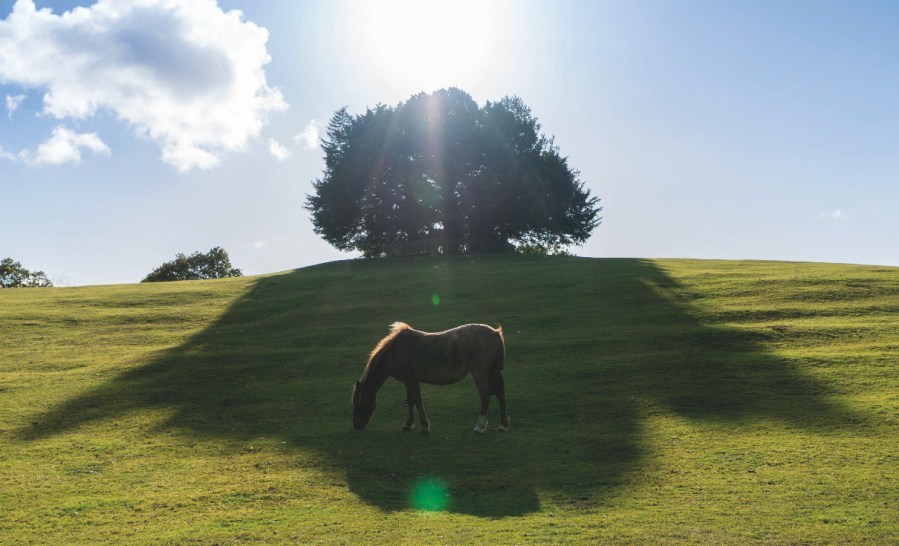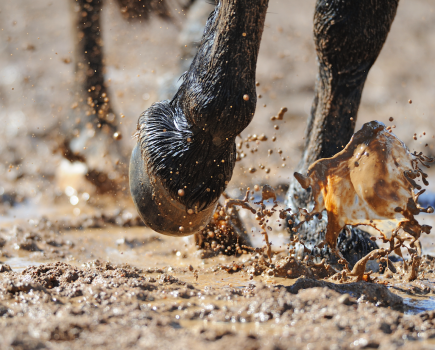It’s getting warmer and is (mostly) sunny, and riding is top of your to-do list. However, as summer approaches there are a number of problems that might put a stop to the fun in the coming season. Vet Sarah Hunter MRCVS rounds up common conditions to look out for and how to prevent them.
1. Lameness
Although we are all keen to get out and about riding as much as possible at this time of year, it is important to build up the exercise intensity gradually to reduce the risk of injury to your horse.
During dry periods in the summer, the ground can become hard, making injuries more likely if a lot of fast work or jumping is performed. To prevent injuries, ensure that the horse is used to being ridden on hard ground by building up work gradually, avoid exercising if the ground is hard and ensure that the horse has rest days to help the legs recover. Using leg wraps or cold hosing the legs after exercise can help to reduce swelling and cool the tendons down after a period of intense exercise.
Some horses can get bruised soles after exercising on hard or stony ground. It is important to check the feet daily, removing any stones trapped in the foot. If the soles are particularly thin, pads may be applied to the foot to prevent injuries. Biotin supplements and hoof treatments can be used to harden the feet, reducing the chance of bruising occurring, but trying to avoid exercising on hard or stony ground is important.
2. Poisonous plants
Usually, toxic plants are avoided by horses as they often taste unpleasant. However, if the field has lots of weeds and there is little grass to eat, the horse may start to eat these plants, and they can also accidentally end up in hay. Fields should be checked regularly for toxic plants as some can grow rapidly.
Weeds should be cut or removed and fallen sycamore seeds should be collected to prevent ingestion.
Plants can cause toxic effects ranging from skin sensitivity (buttercups) to liver damage (ragwort) and need to be eaten in varying quantities to cause severe damage, so it is best to remove all traces of toxic plants from the field. Even dried plants can be toxic so be sure to dispose of dead plants properly.
3. Sunburn
Like us, horses can suffer from sunburn. It mainly affects the less hairy areas such as the muzzle, but other areas with pale or pink skin, such as the heels, can also be affected.
Often the areas become red with some blistering or skin peeling. The signs can be prevented by ensuring that the horse has a shaded area in the field, by applying sun cream to sensitive areas, and with rugs or masks.
4. Field injuries
Before your horse is turned out into the summer pasture, go around the field to check for any barbed wire or broken pieces of fencing. After hedgerows have been cut, sharp pieces can end up inside the hooves or can cause wounds in the skin and injuries to the eyes, so make sure to check your horse over carefully when you bring them in, seeking veterinary advice if any injuries are found.
Horses can become excited when turned out together so ensure they are introduced gradually to avoid any problems – removing the back shoes can help to reduce kick injuries.
5. Allergies
Pollen released into the air from plants and trees can find its way into the respiratory tract of the horse, causing an allergic reaction. Usually, the hairs in the nose trap pollen, preventing it from getting any further. However if there is an overwhelming amount of pollen or if the horse is more susceptible to irritation from pollen, the airways become inflamed and narrowed, making it difficult for the horse to breathe.
Signs of hayfever include coughing, discharge from the eyes and nose, and head shaking. Some horses can develop a skin reaction to pollens and other allergens, seen as lots of raised circular bumps on the skin.
Reducing the horse’s exposure to pollen can be achieved by:
- Stabling the horse during the summer or when pollen counts are high.
- Wearing a nose net during exercise.
- Avoiding riding when the pollen counts are high.
- Regularly topping the fields to prevent grasses from coming to flower.
- Moving yards to an area with different types of pollens.
- Bathing your horse to remove pollens from the skin.
- Cleaning the nostrils to reduce inhalation of pollens.
6. Sweet itch
During the summer, we start to see a lot more flies, which can be annoying for horses and can cause bites that can be itchy and uncomfortable. Sweet itch, the result of an allergic reaction to midge bites, can be particularly frustrating for horses and is very difficult to manage.
Some measures that can be taken to reduce the effects of flies include:
- Putting a fly mask or rug on the horse when they are grazing.
- Keeping the horse inside when flies are at their worst.
- Using a fan in the stable to prevent the flies from flying in and landing on the horse.
- Keeping your horse in a field that has fewer flies, for example, away from standing water or muck heaps.
- Using fly repellent regularly.
- Keeping wounds covered.
- Keeping the mane long or in plaits so that they can swish the flies away.
7. Dehydration
The amount of water required by a horse depends on the amount of work being performed, the diet and if the horse is pregnant or producing milk. During hot weather, dehydration can occur if the horse does not have adequate access to fresh water.
Signs of dehydration include:
- Increased heart rate
- Sticky or dry gums
- Reduced elasticity of the skin (although this can be unreliable)
- Sunken eyes
- Dark urine (this can also be seen with other conditions)
- Lethargy
- Depression
- Reduced urine production
Ensure that horses are offered clean, fresh water constantly, and if it is expected to be hot during the day, try to ride your horse in the morning or evening when the temperature will be lower. If competing in the summer, ensure that your horse is fit enough to take part by building up the type and length of exercise gradually. It is also worth acclimatising them to work during the day as the competition is more likely to take place at those times. Your horse may also benefit from an electrolyte supplement.
8. Colic
A change in the quality or quantity of grass can lead to some types of colic. For example, a sudden growth of lush grass in the summer can result in bloating or gassy colic, and a horse kept on sandy ground, especially with short grass, could start to ingest sand, resulting in abdominal pain.
When speaking to your vet about colic in your horse, it is important to mention what the current diet is and if there have been any recent changes, as this will help to determine the cause of the signs.
Meet the expert: Sarah Hunter BVetMed CertAVP PGCertVPS MRCVS is an equine vet at Clevedale Vets in North Yorkshire. She graduated from the Royal Veterinary College, London in 2012 and holds an RCVS in Advanced Veterinary Practise. In her spare time, she enjoys exploring her local area through riding and running.
Check out our subscription offer










